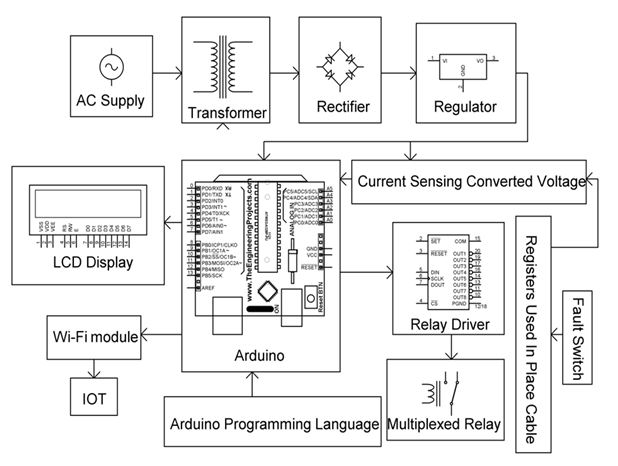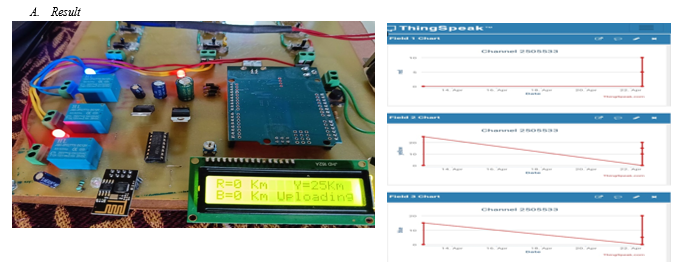Ijraset Journal For Research in Applied Science and Engineering Technology
- Home / Ijraset
- On This Page
- Abstract
- Introduction
- Conclusion
- References
- Copyright
Underground Cable Fault Detection Using IOT
Authors: Prof. Mrs. Gayathri J, Shashank R, Sai Vamshi M, Hareesha K, Mohammed Sohail
DOI Link: https://doi.org/10.22214/ijraset.2024.61944
Certificate: View Certificate
Abstract
The objective of this project is to determine the distance of underground cable fault from base station in kilo meters using an Arduino. The underground cable system is a common practice followed in many urban areas. An issue may happen in an underground cable just because of earth tremors or any burrowing procedure. Since the area of the issue happened is obscure it is very hard for the fixing procedure. This hindrance is handled with the assistance of optical fibre framework. A lot of optical strands is put alongside the force cables. While a fault occurs for some reason, at that time the repairing process related to that particular cable is difficult due to not knowing the exact location of the cable fault. The proposed system is to find the exact location of the fault. The project uses the standard concept of Ohms law i.e., when a low DC voltage is applied at the feeder end through a series resistor (Cable lines), then current would vary depending upon the location of fault in the cable. In case there is a short circuit (Line to Ground), the voltage across series resistors changes accordingly, which is then fed to inbuilt ADC of Arduino to develop precise digital data for display in kilometres. The project is assembled with a set of resistors representing the cable length in km and the fault creation is made by a set of switches at every known km to cross check the accuracy of the same. The fault occurring at a particular distance, the respective phase along with the distance is displayed on the LCD. The same information is also sent over IOT, interfaced to the Arduino. Further this project can be enhanced by using capacitor in an ac circuit to measure the impedance which can even locate the open circuited cable, unlike the short circuited fault only using resistors in DC circuit as followed in the above proposed project. The Methodology is divided into 6 Parts : 1) System Design 2) Component Selection 3) Circuit Design and Schematic Creation 4) Microcontroller Programming 5) LCD Display Integration 6) WI-FI Module Setup All these six parts were assembled together and experiments were then performed to build a system that can update the precise fault location and also display on LCD of Kms where the fault correction is to be carried out.
Introduction
I. INTRODUCTION
In urban areas, cables are laid underground instead of overhead lines. Whenever an underground cable fails, it is difficult to determine the exact location of the fault during the repair of that particular cable.
The proposed system determines the exact location of the cable. It failed and communicated sequentially with the server through the Wi-Fi modem, because the problem in the underground cable was still a big problem.
It is very difficult to find the exact location or fault manually, and the performance of the cable is suddenly affected due to the loss that has occurred. So far, many methods have been implemented to detect cable faults.
However, the problem is how to detect a fault in the cable without grounding, and how to access or restore these data at the location of the fault when necessary. In order to fill these gaps, we have a system that determines the exact location of the fault and sequentially communicates with the server through a Wi Fi modem. The cable length of a phase at the time of failure. For the real worldwide operated voltage distribution lines underground cables have been used from many years. In order to reduce to sensitivity of distribution networks to environmental influences underground voltage cables are highly used. Underground cables have been used in power distribution networks due to the advantages of underground connection, more enhanced security than overhead lines in adverse weather conditions, less liable to damage by storms or lightning. It is less costly for larger distance, eco- friendly and low maintenance cost. But if any fault occurs in cable, then it is difficult to locate fault and its type. So this system is used to detect the location and type of fault in digital way. The requirement of locating the faulty point in an underground cable in order is to facilitate quicker repair, improve the system reliability and reduced outage period.
II. LITERATURE SURVEY
A broad deficiency area model for underground force cable in conveyance framework utilizing voltage and current estimations at the sending-end has just been proposed by Yang, Xia, in a paper distributed in November 2008. The paper presents an investigation of a proportional circuit that models a blamed underground cable framework utilizing circulated parameter approach. Investigation of succession organizes in three-stage arrange by applying the limit conditions is additionally introduced. Utilizing the examination, the area of the issue is resolved with the assistance of current and voltage conditions.
- Westrom distributed in February 1997, clarifies how infusing a progression of tweeted beat streams into the blamed cable, soon after the event of the cable flaw utilizing a heartbeat generator unit can be utilized for an exact count of the area of the cable deficiency. It has been named as 'shortcoming separation locator'.
- Zhao, W in August 2000, proposed a superior way to deal with cable flaw area framework, basically comprising of synchronized testing method, wavelet investigation and voyaging wave standard. Alongside the prologue to three significant methods and a blueprint of the new plan, this paper presents a definite wavelet examination of broken transient waveforms and consequently decides the best wavelet levels for this specific application.
- Gilany et.al distributed in January 2007, introduced a wavelet-based issue area conspire for matured cable frameworks when synchronized advanced deficiency recorded information are accessible at the two terminals of the cable. The wavelet peculiarity identification hypothesis is utilized as an amazing sign handling device to appraise the area of the issue in multiend-matured cable frameworks.
- Schulze, Member, IEEE et.al Peter Schegner , "Two Terminal Fault Location on Unsymmetrical Transmission Lines",IEEE,2010 , introduced the blackout of a line because of an issue can be costly, subsequently the issue must be cleared as quick as could be expected under the circumstances. Computerized security transfers comprise of shortcoming locators dependent on a few strategies.
- Ms Pradnya introduced paper on IoT based innovation visit deficiency in underground cables because of the cessation of paper plastic protection because of compound response or poor workmanship during establishment and the challenges in finding the inexact shortcoming territory have been a major issue. Most Underground Faults are situated by means of uncovering the whole section of cable to empower visual aid review to be completed. On the off chance that where visual examination isn't useful then the whole size of cable is supplanted. This manual strategy isn't just costly yet in addition brings about substantial loss of income to the force dispersion organization.
III. PROBLEM STATEMENT
- Underground cables are susceptible to various underground faults, wear, rodents, etc.
- Many methods have been used in the past to detect cable faults.
- However, the problem is how to detect faults in the ground cable and how to access fault data when necessary.
- This protype intended to detect the location of fault in underground cable lines.
IV. PROPOSED SYSTEM

Numerous techniques are being polished during the most recent couple of decades for cable line shortcoming recognition. The most widely recognized strategy being utilized is overhead cable lines. The deficiencies are handily recognized in this technique however the issue in this strategy is that in some overpopulated urban areas we cannot utilize this technique. So we utilize underground cables. IoT innovation has been actualized in this paper which will examine over the deficiencies over web and this can be observed by a person. With the assistance of potential divider arrange over the cable the framework will have the option to recognize the shortcoming. When an issue is made at a juncture shorting two lines together ,a specific measure of power gets created according to the resistor organize blend. Since existing framework is not effective ,in this paper we propose a framework dependent on IoT. The project uses the standard concept of Ohms law i.e., when a low DC voltage is applied at the feeder end through a series resistor (Cable lines), then current would vary depending upon the location of fault in the cable. In case there is a short circuit (Line to Ground), the voltage across series resistors changes accordingly, which is then fed to inbuilt ADC of Arduino to develop precise digital data for display in kilo meters. The project is assembled with a set of resistors representing the cable length in km and the fault creation is made by a set of switches at every known km to cross check the accuracy of the same. The fault occurring at a particular distance, the respective phase along with the distance is displayed on the LCD. The same information is also sent over IOT, interfaced to the Arduino. Further this project can be enhanced by using capacitor in an ac circuit to measure the impedance which can even locate the open circuited cable, unlike the short circuited fault only using resistors in DC circuit as followed in the above proposed project. For the real worldwide operated voltage distribution lines underground cables have been used from many years. In order to reduce to sensitivity of distribution networks to environmental influences underground voltage cables are highly used. Underground cables have been used in power distribution networks due to the advantages of underground connection, more enhanced security than overhead lines in adverse weather conditions, less liable to damage by storms or lightning. It is less costly for larger distance, eco- friendly and low maintenance cost. But if any fault occurs in cable, then it is difficult to locate fault and its type. So this system is used to detect the location and type of fault in digital way. The requirement of locating the faulty point in an underground cable in order is to facilitate quicker repair, improve the system reliability and reduced outage period. The supply is given whenever we will give the supply Under Ground Cable Fault is displayed on the LCD. The module is getting connected to the Wi-Fi it is displayed here Wi-Fi connecting. So initially it showing R=0 Y=0 and B=0 Km so if we want create a fault in R phase at distance 10km we just straights the switch towards the ground that is this switch gets grounded and it is displayed that R=10 km and the respective R phase relay goes of which is indicated by the LED. So if we want to create a fault in the Y phase at a distance of 20km we will just slide this switch towards the ground so Y=20 km. So if we want to in a B phase at a distance of 25km just we slide this switch so B=25 km so whenever the faut is created at a particular phase those respective relays goes off which is indicated by the LCDs . So the whole data will be uploaded over the IOT page and it is displayed here uploading.
V. RESULT & DISCUSSION

B. Discussion
Cables help power distribution. These cables have so many defects that it is difficult to find the defects in these cables. The system uses Arduino Uno to fix an error. Turn up cable. Nowadays in many non-rural areas, the generally, underground cables are used instead of overhead lines. The system uses the Arduino Uno board. The fault is caused by multiple turnouts, and the track fault is displayed on the LCD screen and website the paper IOT based underground fault detector is used for detecting any flaws in an underground cable system. This system can clearly choose the region where the fault has occurred and can send the co-ordinates to the user as well as displays in the LCD display screen. Henceforth the strategy used in this paper works in a consecutive way and ends up being helpful in discovery and area of deficiencies in underground cables. Through this project we simplified the actual problem of the detecting the fault in the underground area. We discover the position or location where the fault will be occurred and also find the accurate distance of breaker point. The line to line, single line, line to ground fault in the underground cable is located to rectify the fault efficiently using simple concepts of Ohms law. The work automatically displays the phase, distance and time of occurrence of fault with the help of ATMEGA16 and ESP8266 Wi - Fi module in a webpage. The benefits of accurate location of fault are fast repair to revive back the power system, it improves the system performance, it reduces the operating expense and the time to locate the faults in the field. The open circuit fault can be detected using a capacitor in ac circuit which measures the change in impedance and calculate the distance of fault.
VI. ADVANTAGES
- Less maintenance
- It has higher efficiency
- Less fault occur in underground cable This method is applicable to all types of cable ranging from 1kv to 500kv
- It can detect other types of cable fault such as Short circuit fault, cable cuts, Resistive fault, Sheath faults, Water trees Partial discharges.
Conclusion
1) Cables help power distribution. These cables have so many defects that it is difficult to find the defects in these cables. The system uses Arduino Uno to fix an error. Turn up cable. Nowadays in many non-rural areas, the generally, underground cables are used instead of overhead lines. The system uses the Arduino Uno board. The fault is caused by multiple turnouts, and the track fault is displayed on the LCD screen and website 2) The paper IOT based underground fault detector is used for detecting any flaws in an underground cable system. This system can clearly choose the region where the fault has occurred and can send 3) The co-ordinates to the user as well as displays in the LCD display screen. Henceforth the strategy used in this paper works in a consecutive way and ends up being helpful in discovery and area of deficiencies in underground cables. 4) The proposed system in this detects only the location of short circuit fault in underground cable line, and also detect the location of open circuit fault, to detect the open circuit fault capacitor used in circuit which measure the change in resistance & calculate the distance of fault. 5) For future research, the system would proceed with similar neural networks structure for different types fault section and fault location estimation.
References
[1] Mr. Kiran Wadekar , Mr. Vaibhav Borkar ,Mr. Rahul Ghule , Prof. Manish Patel -IoT Underground Cable Fault Detection ,IEEE PROCEEDINGS, vol-3 Issue-3 2017 . [2] Tanmay Kedia , Abhijeet Lal , Dr . Abhishek Verma , Assistant Professor, Department of EEE, BIT Durg, Chhattisgarh - IoT Technology Based Underground Cable Fault Distance Detection System UsingATmega328P Microcontroller, IJIRSET,vol-7,Issue-3 ,March 2018 . [3] Ajay Singh and M. A. Ansari , Department of Electrical Engineering Gautam Buddha University ,vol4,Issue-1 ,March 2017 . [4] Mr. N. Sampathraja , Dr . L. Ashok Kumar , Ms. V. Kirubalakshmi and Ms. C. Muthumaniyarasi, Mr. K.Vishnu Murthy-IoT Based Underground Cable Fault Detector, IJMET Publication ,vol-8,Issue-8, August 2017 . [5] E. C. Bascom, -Computerized underground cable fault location expertise, lin Proc. IEEE Power Eng. Soc. General Meeting, Apr. 10–15,1994, pp.376–382.J. Clerk Maxwell, A Treatise on Electricity and Magnetism, 3rded., vol. 2. Oxford: Clarendon, 1892, pp.68–73. [6] E. C. Bascom, -Computerized underground cable fault location expertise, lin Proc. IEEE Power Eng. Soc. General Meeting, Apr. 10–15,1994, pp.376–382.J. Clerk Maxwell, A Treatise on Electricity and Magnetism, 3rded., vol. 2. Oxford: Clarendon, 1892, pp.68–73.
Copyright
Copyright © 2024 Prof. Mrs. Gayathri J, Shashank R, Sai Vamshi M, Hareesha K, Mohammed Sohail. This is an open access article distributed under the Creative Commons Attribution License, which permits unrestricted use, distribution, and reproduction in any medium, provided the original work is properly cited.

Download Paper
Paper Id : IJRASET61944
Publish Date : 2024-05-11
ISSN : 2321-9653
Publisher Name : IJRASET
DOI Link : Click Here
 Submit Paper Online
Submit Paper Online

